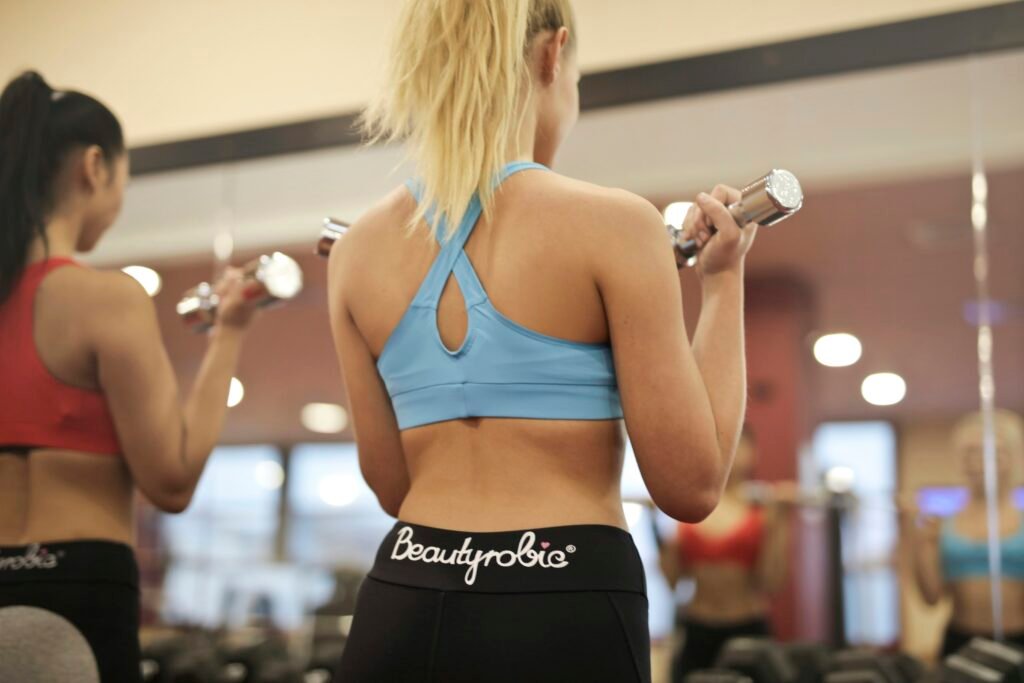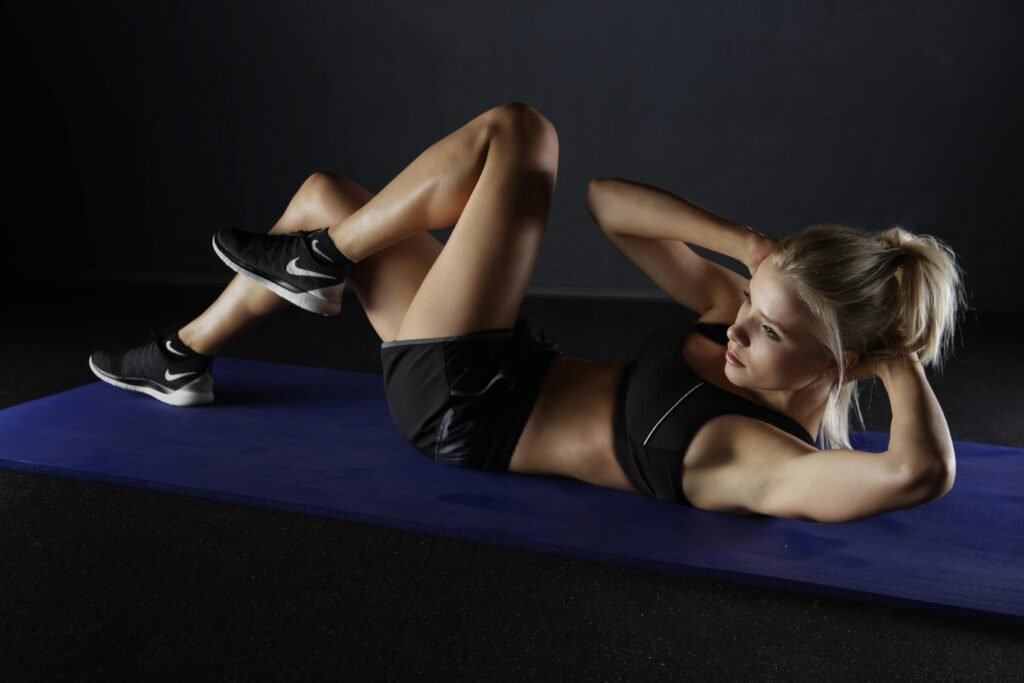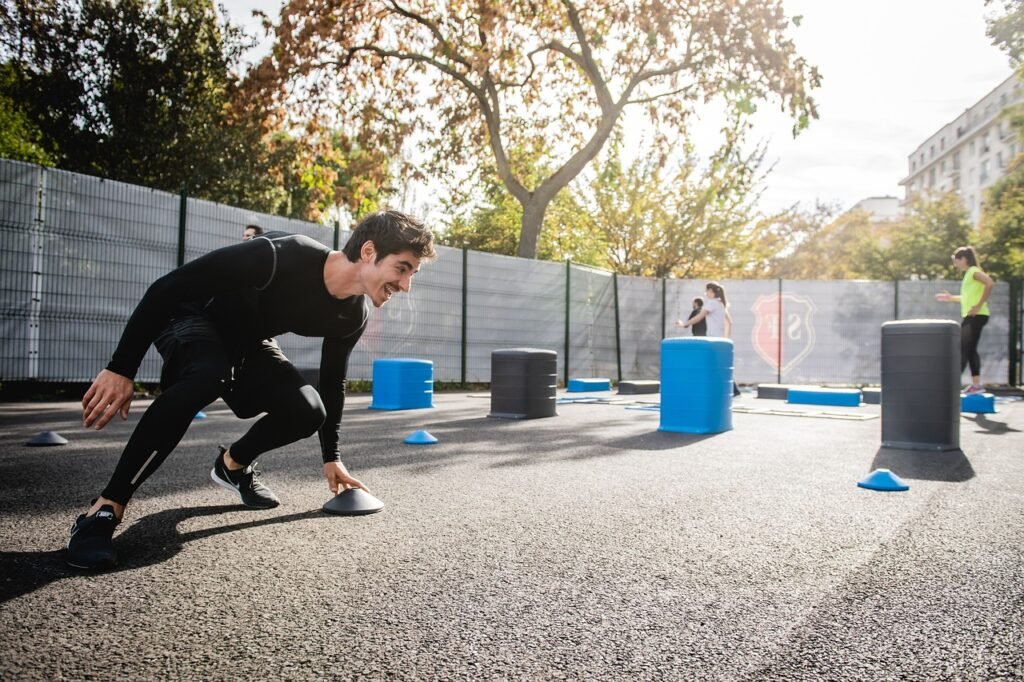
Getting into a new exercise routine is an exciting adventure, but it can also come with its fair share of challenges – particularly when it comes to cleaning and sanitizing used exercise gear. With sweat, bacteria, and various odors lingering on your equipment, it’s crucial to know the best techniques for keeping your gear clean and safe. In this ultimate guide, we’ll walk you through everything you need to know about effectively cleaning and sanitizing your used exercise gear, so you can focus on achieving your fitness goals with peace of mind.

This image is property of images.pexels.com.
Importance of Cleaning and Sanitizing Used Exercise Gear
Keeping your exercise gear clean and sanitized is of utmost importance for several reasons. Not only does it help prevent illnesses and infections, but it also prolongs the lifespan of your equipment and ensures proper hygiene and freshness during your workouts. By following a proper cleaning routine, you can maintain a healthy environment for yourself and anyone else who uses the gear.
Prevention of Illness and Infections
Regular cleaning and sanitizing of used exercise gear is crucial in preventing the spread of illnesses and infections. During your workouts, you come into contact with various surfaces and equipment that may harbor bacteria, viruses, and fungi. Sweat and bodily fluids can contribute to the growth of these microorganisms. By cleaning and sanitizing your gear, you can eliminate these harmful pathogens and reduce the risk of contracting infections such as skin conditions, respiratory issues, and gastrointestinal illnesses.

This image is property of images.pexels.com.
Prolonging the Lifespan of the Gear
Proper cleaning and sanitizing routines can significantly extend the lifespan of your exercise gear. Over time, sweat, dirt, and oils can accumulate on the surfaces of the equipment, causing deterioration and potential damage. Regular cleaning removes these contaminants, preventing corrosion, wear, and tear. By taking care of your gear, you can ensure its longevity and save yourself from frequent replacements and costly repairs.
Maintaining Hygiene and Freshness
Nobody wants to work out on dirty or unpleasant-smelling equipment. Regular cleaning and sanitizing help maintain proper hygiene and freshness, providing a more comfortable workout experience. Eliminating any accumulated sweat, odors, or grime not only improves the overall cleanliness of the gear but also enhances your motivation and enjoyment while exercising. Plus, a fresh and clean environment can boost your mental focus and elevate your workout performance.

This image is property of images.pexels.com.
Identifying the Types of Exercise Gear
Exercise gear can encompass various types of equipment, each requiring specific cleaning methods. To ensure thorough and effective cleaning, it’s vital to understand the different categories of exercise gear:
Cardiovascular Equipment
Cardiovascular equipment includes treadmills, ellipticals, stationary bikes, and rowing machines. These machines are often heavily used and require regular cleaning due to sweat accumulation, which can make them hotspots for bacteria and germs.
Strength Training Equipment
Strength training equipment consists of dumbbells, weight machines, kettlebells, and resistance bands. These items often come into direct contact with your skin and sweat, making regular cleaning essential to prevent the spread of germs and maintain their functionality.
Yoga and Pilates Equipment
Yoga and Pilates equipment include yoga mats, Pilates reformers, blocks, straps, and exercise balls. These items are often used in close proximity to the body and can accumulate sweat, oils, and bacteria. Proper cleaning helps maintain the hygiene and integrity of these accessories.
Accessories and Small Equipment
Accessories and small equipment encompass items like jump ropes, resistance bands, exercise balls, and foam rollers. These items can easily collect dirt, sweat, and bacteria, making regular cleaning crucial to ensure their effectiveness and longevity.
General Cleaning Guidelines
To effectively clean and maintain your exercise gear, follow these general cleaning guidelines:
Pre-Cleaning Inspection
Before cleaning your exercise gear, conduct a visual inspection to identify any visible dirt, stains, or damages. This inspection will help you determine the cleaning method and supplies required for each piece of equipment.
Gathering the Right Cleaning Supplies
Different types of exercise gear may require specific cleaning supplies. Common cleaning supplies include mild detergent, water, vinegar, microfiber cloths, brushes, and disinfectants. Always check the manufacturer’s instructions to ensure you’re using the appropriate cleaners.
Cleaning Techniques for Different Materials
Exercise gear may be made of various materials, such as plastic, rubber, metal, fabric, or leather. Each material may require a different cleaning technique. For example, plastic surfaces can often be wiped down with a damp cloth, while fabric-covered items may need to be machine-washed or spot-cleaned. Refer to the equipment’s care instructions for the best cleaning method.
Avoiding Harsh Chemicals
While it’s important to thoroughly clean your exercise gear, avoid harsh chemicals that may damage the equipment or cause skin irritation. Stick to mild cleaners and disinfectants, and always test a small, inconspicuous area before applying them to the entire item.
Drying and Storing the Gear
After cleaning, ensure your exercise gear is completely dry before storing it. Moisture can promote the growth of mold and mildew. Properly store your gear in a clean and dry area to maintain its cleanliness and prevent any potential damage.

This image is property of images.unsplash.com.
Cleaning Cardiovascular Equipment
Properly cleaning cardiovascular equipment such as treadmills, ellipticals, stationary bikes, and rowing machines is essential to maintain hygiene and prevent the spread of germs. Here are specific cleaning guidelines for each type of equipment:
Treadmills
Treadmills often accumulate sweat and dirt on their belts, handles, and consoles. Start by turning off and unplugging the treadmill. Wipe down the surfaces with a damp cloth and mild detergent, paying extra attention to areas prone to sweat accumulation. For the belt, use a gentle cleaner recommended by the manufacturer or a mild mixture of dish soap and water. Be sure to dry the belt thoroughly before using the treadmill again.
Ellipticals
Similar to treadmills, ellipticals require regular cleaning to remove sweat and dirt from the surfaces. Disconnect the elliptical from the power source, then wipe down the handles, pedals, and console with a damp cloth and mild detergent. For hard-to-reach areas, use a soft brush or a cotton swab. Dry all surfaces thoroughly before using the equipment.
Stationary Bikes
To clean a stationary bike, start by unplugging it and wiping down the handles, seat, pedals, and console with a damp cloth and mild detergent. Pay special attention to intricate areas that may accumulate sweat or dust. For any plastic or metal parts, use a gentle cleaner or a mixture of water and vinegar. Finally, dry the bike completely before using or storing it.
Rowing Machines
When cleaning a rowing machine, disconnect it from the power source and wipe down the handles, seat, footrests, and any other surfaces with a damp cloth and mild detergent. For any metal or plastic parts, use a gentle cleaner or a mixture of water and vinegar. Pay attention to any exposed cables or moving parts and ensure they are free from dust or debris. Once cleaned, thoroughly dry the machine before use.
Cleaning Strength Training Equipment
Regular cleaning of strength training equipment is essential to maintain cleanliness and prevent the spread of germs. Here are specific cleaning guidelines for various types of equipment:
Dumbbells and Free Weights
Start by visually inspecting the dumbbells and free weights for any visible dirt or damage. Use a cloth or sponge dampened with mild detergent to clean the handles and weights. For textured or rubber-coated surfaces, use a soft brush or cloth to remove any debris. Rinse the equipment thoroughly and dry it completely before storing.
Weight Machines
Weight machines often have multiple surfaces, including upholstered seats and cushions, metal frames, and plastic handles. Use a cloth or sponge with mild detergent to clean the surfaces, paying extra attention to the seat and backrest areas. For any leather or fabric upholstery, follow the manufacturer’s instructions for cleaning. Dry all surfaces thoroughly before using the equipment again.
Kettlebells
Kettlebells are typically made of metal and can gather sweat and dirt. To clean them, wipe the surfaces with a cloth or sponge dampened with mild detergent or a mixture of water and vinegar. Pay attention to the handle area, where most contact occurs. Once cleaned, dry the kettlebells thoroughly before storing them to prevent rusting.
Resistance Bands
Resistance bands can accumulate sweat, dirt, and oils. To clean them, fill a basin or sink with warm water and mild detergent. Immerse the resistance bands and gently rub each one to remove any debris. Rinse the bands thoroughly and hang them to air dry before storing.

This image is property of images.unsplash.com.
Cleaning Yoga and Pilates Equipment
Maintaining the cleanliness of yoga and Pilates equipment will ensure a hygienic and pleasant workout experience. Here are specific cleaning guidelines for different types of equipment:
Yoga Mats
Yoga mats come into direct contact with your body and can accumulate sweat and dirt. To clean them, use a mild detergent or a yoga mat cleaner recommended by the manufacturer. Apply the cleaner to a soft cloth or sponge and clean the surface of the mat. Rinse the mat with water and gently pat it dry with a towel. Allow the mat to air dry completely before rolling it up for storage.
Pilates Reformer
Pilates reformers are usually upholstered and can collect sweat and oils. Wipe down the surfaces with a cloth or sponge dampened with mild detergent or a mixture of water and vinegar. Pay attention to the areas where sweat accumulates the most. Follow the manufacturer’s instructions for any specific cleaning recommendations. Once cleaned, thoroughly dry the reformer before using it again.
Yoga Blocks and Straps
Yoga blocks and straps can gather dirt and sweat. To clean them, wipe the surfaces with a cloth or sponge dampened with mild detergent or a mixture of water and vinegar. Pay attention to any textured surfaces or straps with buckles. Rinse the blocks and straps with water and allow them to air dry completely before placing them in storage.
Exercise Balls
Exercise balls are prone to sweat accumulation and require regular cleaning. Start by visually inspecting the ball for any visible dirt or damage. Wipe down the surface with a cloth or sponge dampened with mild detergent. For any persistent stains, use a soft brush. Rinse the ball with water and allow it to air dry thoroughly before using or storing it.
Cleaning Accessories and Small Equipment
Accessories and small equipment play an essential role in workouts and require regular cleaning to maintain their effectiveness. Here are specific cleaning guidelines for different types of accessories:
Jump Ropes
Jump ropes can accumulate sweat, oils, and dirt. To clean them, dampen a cloth or sponge with mild detergent or a mixture of water and vinegar. Wipe down the length of the jump rope, paying attention to any textured handles. Rinse the rope thoroughly, removing any soap residue, and hang it to air dry before storing.
Resistance Bands
Cleaning resistance bands is similar to cleaning them in the strength training equipment section. Refer to the steps mentioned earlier to ensure proper cleaning and drying.
Exercise Balls
Exercise balls are described in the yoga and Pilates equipment section. Refer to the steps provided earlier to properly clean and dry exercise balls.
Foam Rollers
Foam rollers can gather sweat, oils, and dirt over time. To clean them, wipe the surface with a cloth or sponge dampened with mild detergent or a mixture of water and vinegar. Pay extra attention to any textured areas. Rinse the foam roller thoroughly and allow it to air dry completely before using or storing it.
Sanitizing Used Exercise Gear
In addition to regular cleaning, sanitizing used exercise gear is crucial for maintaining a hygienic workout environment. Here are some important points to consider when sanitizing your gear:
Understanding the Importance of Sanitizing
Sanitizing goes beyond regular cleaning by eliminating a significant number of pathogens on the equipment’s surfaces. This step is essential to prevent the spread of germs and reduce the risk of infections.
Choosing the Right Sanitizing Agents
When selecting a sanitizing agent, consider ones that are effective against bacteria, viruses, and fungi. Common options include isopropyl alcohol solutions, disinfectant wipes, or bleach solutions. However, always follow the manufacturer’s instructions and safety guidelines when using these products.
Applying Sanitizing Techniques for Different Gear
For hard surfaces such as metal or plastic, use disinfectant wipes or a cloth soaked in a sanitizing solution. Wipe down all surfaces, paying extra attention to high-touch areas like handles, buttons, and consoles. For fabric-covered gear, follow the manufacturer’s instructions for sanitizing or consider using fabric-safe disinfectant sprays or wipes. Always ensure the gear is completely dry before use.
Focusing on High-Touch Surfaces
High-touch surfaces on exercise gear, such as handles, buttons, or touchscreens, are more likely to accumulate germs and bacteria. Take extra care to thoroughly sanitize these areas to minimize the risk of contamination.
Maintenance Tips to Keep Gear Clean
Alongside regular cleaning and sanitizing, following these maintenance tips will help keep your exercise gear clean and in optimal condition:
Regular Cleaning Schedule
Set a regular cleaning schedule for your exercise gear based on usage. This schedule ensures that cleaning is not neglected and reduces the chances of dirt and grime buildup. Consider cleaning your gear at least once a week or more frequently for heavily used equipment.
Proper Storage
Storing your exercise gear properly is crucial for maintaining its cleanliness and condition. Ensure that gear is stored in a clean and dry area, away from direct sunlight or moisture. Separate items that come into direct contact with skin to prevent the spread of bacteria.
Washing Clothing and Accessories
Don’t forget to wash your workout clothing, towels, and accessories regularly. These items can harbor sweat, bacteria, and odor, potentially transferring them to your exercise gear. Follow the care instructions on the clothing labels and use mild detergent to remove dirt and sweat effectively.
Encouraging Personal Hygiene
Promote personal hygiene practices among yourself and anyone who shares your exercise space. Encourage the use of clean towels, hand sanitizers, and proper handwashing techniques before and after using the gear. By prioritizing personal hygiene, you further reduce the risk of infections and maintain a clean workout environment.
Conclusion
Cleaning and sanitizing used exercise gear is crucial for your health, the longevity of the equipment, and the overall enjoyment of your workout experience. By following the outlined cleaning guidelines, specific cleaning techniques for different gear, and incorporating maintenance tips into your routine, you can ensure a fresh and hygienic workout environment. Remember, regular cleaning, proper storage, and personal hygiene practices go a long way in optimizing the cleanliness and effectiveness of your exercise gear. So, lace up your workout shoes, grab your clean gear, and enjoy a rejuvenating and hygienic workout experience!


